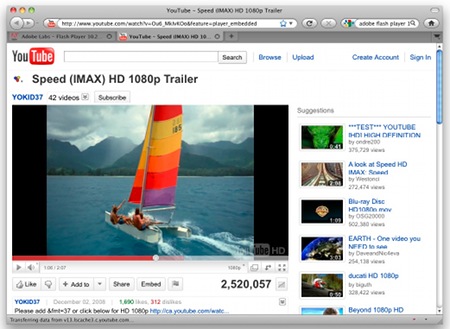Flash Player update supports AMD Fusion chips
Feb 9, 2011 — by LinuxDevices Staff — from the LinuxDevices Archive — 5 viewsAdobe announced a final version of its Flash Player 10.2, touting new features such as support for full-screen mode on multiple monitors. The software now gains accelerated 1080p video from more GPUs (graphical processing units), including those built into AMD's recently announced Fusion E-Series and C-Series chips, according to the company.
Adobe's Flash Player is described as a "a cross-platform browser-based application runtime that provides uncompromised viewing of expressive applications, content, and videos across screens and browsers." Once associated mainly with interactive ad banners and simple games, it has become a mainstay of web video, offered by sites like Hulu, YouTube, and countless others.
The company's last significant upgrade of its desktop version, Flash Player 10.1, was released last year. A key addition at the time was hardware decoding of H.264 video on computers using GPUs from AMD/ATI GPUs (Radeon HD and FirePro), Broadcom (Crystal HD BCM70012 and BCM70015), Intel (GMA500, 4 Series chipset, 2010 Core processors), and Nvidia (GeForce, Ion, and Quadro). However, GPU assistance wasn't available either on Linux or Mac OS X desktops.

A demonstration of Adobe's Flash Player 10.2 playing back 1080p video
(Click to enlarge)
Flash Player 10.2 again majors in hardware decoding, but this time extends its reach further downwards, toward low-power and embedded devices. According to AMD, it worked with Adobe to enable accelerated 1080p video decoding on the E-Series and C-Series APUs ("advanced processing units"), now making their way into notebooks (such as the HP Pavilion dm1z we recently reviewed) and other products.
Adobe says Flash Player 10.2's enhanced performance on the AMD APUs, as well as the other supported GPUs, is due to Stage Video, "a new method for video playback." This "dramatically decreases" processor usage and also lowers the amount of RAM flash requires, the company claims.
According to Adobe's release notes, when Flash video playback is switched into full-screen mode on a secondary monitor, it will remain that way even when user are doing work on their main screens. (In our brief testing of the upgrade, this proved to be true, though not with Firefox 3 — a known issue, says Adobe.)
Other improvements in Flash Player 10.2 include the ability for developers to define custom native mouse cursors, security enhancements, and improved text readability, according to Adobe. Flash Player also now takes advantage of harware-accelerated graphics in Internet Explorer 9, "utilizing hardware rendering surfaces to improve graphics performance and enable seamless composition," the company says.
Adobe adds that H.264 hardware decoding on Linux is still considered an "experimental feature," though it has been tested on Nvidia GT 330 and Broadcom BCM70015 GPUs. Users may enable it by adding the command EnableLinuxHWVideoDecode=1 to an mms.cfg configuration file, but might "experience instability and crashes while watching hardware-accelerated video," the company warns.
According to Adobe, Flash Player 10.2 no longer supports Windows 2000 or PowerPC-based computers. The latter is because of "performance enhancements that cannot be supported on the older PowerPC architecture," the company says.
John Taylor, director of client product and software marketing for AMD, stated, "AMD and Adobe worked together to enable AMD accelerated parallel processing technology through Flash Player 10.2 to bring users an enriched, more vivid video experience. Adobe continues to work towards ensuring top-notch delivery of web and video content, and remains the number one video platform on the web today."
Further information
In some cases, such as with Google's Chrome browser, users will find that the 10.2 update of the Flash Player is installed on their computers automatically. Instructions for installing the update (currently version 10.2.152) manually can be found on Adobe's website.
This article was originally published on LinuxDevices.com and has been donated to the open source community by QuinStreet Inc. Please visit LinuxToday.com for up-to-date news and articles about Linux and open source.